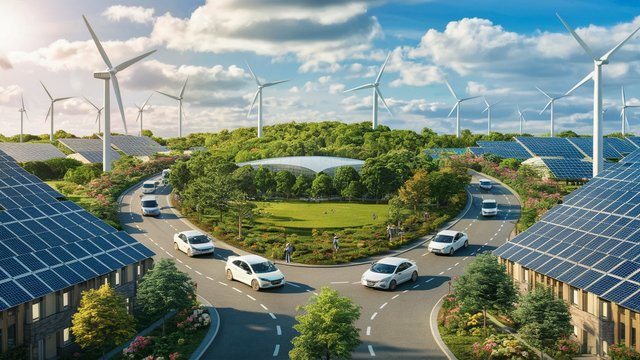The Role of Renewable Energy in Protecting Our Environment: Powering a Sustainable Future

The Earth, our beautiful planet, is facing a multitude of environmental challenges. Climate change, air and water pollution, and habitat loss are just a few of the pressing issues demanding our attention. As we strive to create a more sustainable future, one crucial element stands out: the role of renewable energy in protecting our environment.
For decades, our reliance on fossil fuels like coal, oil, and gas has fuelled our economies and powered our lives. However, the burning of these fuels releases harmful greenhouse gases into the atmosphere, trapping heat and causing global temperatures to rise. This warming planet disrupts weather patterns, melts glaciers, and raises sea levels, threatening entire ecosystems and coastal communities.
Renewable energy offers a beacon of hope in this complex scenario. Unlike fossil fuels, renewable sources are naturally replenished and produce little to no greenhouse gas emissions during operation. By embracing solar, wind, geothermal, hydropower, and biomass energy, we can significantly reduce our environmental footprint and pave the way for a cleaner, healthier planet.
Combating Climate Change: The Power of Renewables
The role of renewable energy in protecting our environment is perhaps most evident in its ability to combat climate change. Solar panels, wind turbines, and geothermal plants generate electricity without releasing planet-warming carbon dioxide (CO2). Studies show that a large-scale shift to renewables could drastically reduce global CO2 emissions, mitigating the worst effects of climate change.
Imagine a world where our cities are powered by the sun's rays, our homes are heated by the Earth's core, and our transportation relies on the power of the wind. This vision, once a dream, is becoming increasingly achievable with advancements in renewable energy technologies. As costs continue to decline and efficiencies rise, renewables are not just environmentally friendly, but also a viable economic alternative.
Breathing Easier: Cleaner Air and Reduced Pollution
Fossil fuel combustion is a major contributor to air pollution, leading to smog, acid rain, and respiratory illnesses. The role of renewable energy in protecting our environment extends to improving air quality. Renewable energy sources produce minimal to no air pollutants, creating a healthier environment for us all.
Transitioning to clean energy can significantly reduce smog formation in urban areas, leading to clearer skies and improved public health. Power plants that rely on wind or solar don't release harmful pollutants like sulfur dioxide and nitrogen oxides, which contribute to acid rain and damage ecosystems. By embracing renewables, we can breathe easier, literally.
Protecting Our Waters: Minimising Environmental Impact
Our water resources are vital for life, yet they are often threatened by the consequences of fossil fuel extraction and use. Oil spills, water contamination from fracking, and thermal pollution from power plants are just some of the environmental impacts we need to address.
The role of renewable energy in protecting our environment includes safeguarding our precious water sources. Renewable energy technologies have minimal impact on water resources. Solar and wind farms require little to no water for operation, unlike traditional power plants that use vast quantities for cooling purposes. Additionally, hydropower, when developed responsibly, can be a sustainable source of renewable energy.
By transitioning to a renewable energy future, we can minimise the risk of water contamination and ensure cleaner, healthier water sources for generations to come.
Preserving Habitats and Biodiversity
The delicate balance of our ecosystems is often disrupted by human activities, particularly those associated with fossil fuel extraction. Habitat destruction, deforestation for mining, and oil spills all contribute to biodiversity loss.
The role of renewable energy in protecting our environment encompasses safeguarding the natural world. Renewable energy sources often have a smaller footprint compared to traditional energy infrastructure. Solar panels can be installed on rooftops, wind turbines can coexist with farmland, and geothermal plants can be built with minimal disruption to surrounding areas.
This shift towards clean energy can help protect vital habitats for wildlife and promote biodiversity. By reducing our reliance on fossil fuels, we can create a more sustainable future for all living things.
Beyond Environmental Benefits: A Brighter Future
The role of renewable energy in protecting our environment is undeniable. But the benefits extend far beyond a cleaner planet. Transitioning to renewables can create new green jobs, boost energy independence, and foster innovation in clean technologies.
Renewable energy projects can create opportunities in manufacturing, installation, and maintenance, providing a much-needed boost to local economies. Additionally, by relying on domestic renewable resources, countries can reduce dependence on imported fossil fuels, leading to greater energy security. Moreover, the development of new renewable energy technologies fosters innovation and paves the way for a more sustainable future.
The journey towards a renewable energy future won't be without challenges. However, the potential rewards are immense. By embracing clean energy, we can create a healthier planet, ensure a sustainable future for generations to come and build a brighter tomorrow for all.
💕💕Let's all play our part in supporting the role of renewable energy in protecting our environment.🌹🌹
Upvoted! Thank you for supporting witness @jswit.